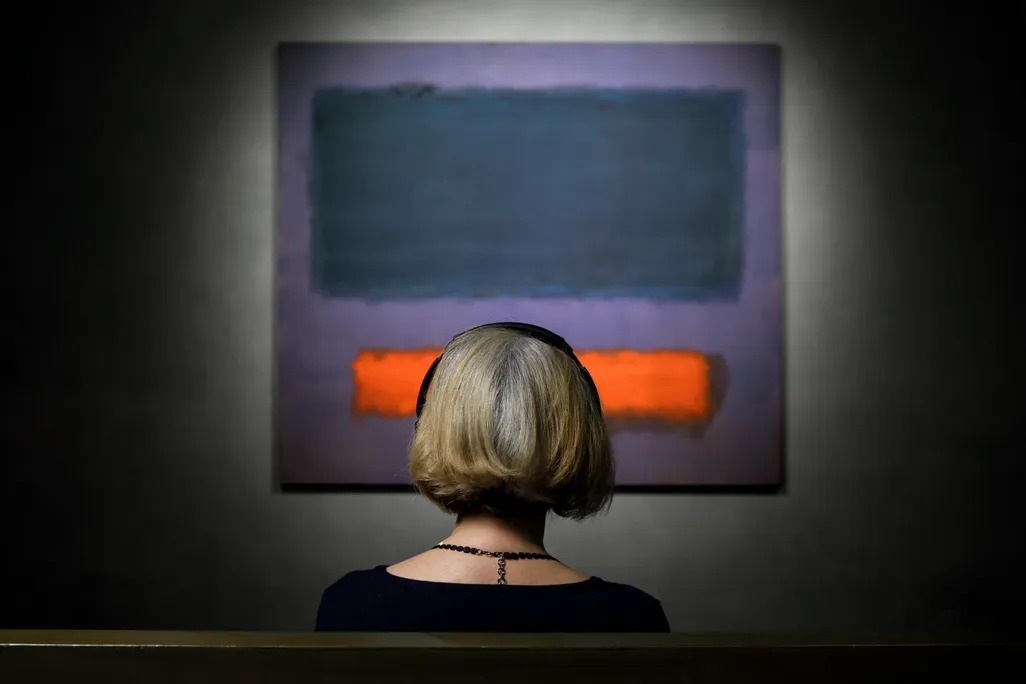Child Scratches Mark Rothko Painting Worth Millions While Visiting Dutch Art Museum
Child Scratches Mark Rothko Painting Worth Millions While Visiting Dutch Art Museum
Artworks by the Latvian-American Abstract Expressionist have been damaged before, but repairs have added up to hundreds of thousands of dollars
Grey, Orange on Maroon, No. 8, Mark Rothko, 1960
Aad Hoogendoor / Museum Boijmans Van Beuningen
A monumental Mark Rothko painting was removed from view at a Dutch art museum after a child scratched the canvas.
Grey, Orange on Maroon, No. 8 was a highlight of the Museum Boijmans Van Beuningen in Rotterdam, which boasts a collection spanning from the middle ages to modern times. It’s one of only two works by the Latvian-American Abstract Expressionist in public collections in the Netherlands. Conservation experts are now assessing the extent of the damage, as well as the cost of repairing a painting likely worth tens of millions of dollars.
The artwork “sustained superficial damage after a child touched the painting when it was on display,” says the museum in a statement, per Euronews’ David Mouriquand. “As a result, small scratches are visible in the unvarnished paint layer in the lower part of the painting.”
Created in 1960, Grey, Orange on Maroon, No. 8 measures 7.5 feet high by 8.5 feet wide. It’s a prime example of Rothko’s “color field” paintings, which prompt emotional responses through large blocks of carefully mixed colors.
“I am not an Abstractionist,” Rothko once reportedly told art critic Selden Rodman. “I’m not interested in relationships of color or form. … I’m interested only in expressing basic human emotions—tragedy, ecstasy, doom and so on—and the fact that lots of people break down and cry when confronted with my pictures shows that I communicate those basic human emotions.”
Grey, Orange on Maroon, No. 8 was damaged while on display at the museum's depot site, which is accessible to the public as renovations continue on the main building.
Aad Hoogendoor / Museum Boijmans Van Beuningen
Turning emotion into paint required the artist to develop a mastery of colors and materials in his paintings. “Rothko’s mixture of pigments and resins and glues were quite complex,” Jonny Helm, a marketing manager at Plowden & Smith, an art restoration service in England, tells BBC News’ Anna Lamche.
While the museum has not provided an estimated cost of the repairs, Rothko works regularly fetch millions at auction. For example, Orange, Red, Yellow (1961) sold for nearly $87 million in May 2012.
That same year, a vandal at the Tate Modern in London deliberately defaced Rothko’s 1958 painting Black on Maroon (1958) with graffiti. The vandal was sentenced to two years in prison. Experts estimated that repairs would take 18 months and the equivalent of more than $350,000 in today’s money.
However, a child scratching a painting is a much different scenario. A spokesperson for the museum tells the Dutch newspaper Algemeen Dagblad’s Antti Liukku that the painting was damaged while it was on display at the museum’s depot, accessible to the public as the main building undergoes renovation.
But the incident raises new questions about how to make artworks accessible—particularly for younger audiences—while also protecting them from harm.“Every museum and gallery thinks hard about how to balance meaningful physical access to artworks and objects with keeping them safe. I’d say most have the balance right, but accidents can still happen,” Maxwell Blowfield, the creator of the “maxwell museums” newsletter, explains to CNN’s Lianne Kolirin. “It’s impossible to prevent every potential incident, from visitors of all ages. Thankfully, things like this are very rare compared to the millions of visits taking place every day.”
Who will pay for the repairs is also unclear. Rachel Myrtle, a fine art insurance expert at Aon, tells BBC News that art museum insurance policies tend to cover “all risks associated with physical loss and damage to artwork.”
But in 2011, when a tourist at the Museum Boijmans Van Beuningen accidentally stepped on Pindakaasvloer—a conceptual work created by Wim T. Schippers in the 1960s in which the floor is covered in peanut butter—the museum asked the tourist to pay restoration costs, per Euronews.
In other cases, however, museums have been more understanding—especially when children are involved. Last August, a 4-year-old boy accidentally shattered a 3,500-year-old Bronze Age jar at the Hecht Museum in Haifa, Israel. Instead of punishing the boy or his parents, the museum used the accident “as a teaching opportunity,” inviting the family back to the museum to see how experts conducted repairs, Julia Binswanger wrote for Smithsonian magazine.
For now, the Museum Boijmans Van Beuningen is researching “next steps for the treatment of the painting,” including other examples of successful Rothko restorations, per the statement. “We expect that the work will be able to be shown again in the future.”
Get the latest stories in your inbox every weekday.


